酸碱性是土壤的重要化学性质,常以pH表示。土壤酸碱性是土壤退化的主要指标之一,其动态变化影响着土壤微生物活性、养分转化、元素迁移、植物生长等[1-2]。国内外学者对土壤pH变化做了诸多研究,自然状态下,土壤pH变化过程十分缓慢,变化一个单位需要漫长的时间[3-4],但近年来,快速的城市化进程和不合理的农业生产方式导致土壤酸碱性发生了明显改变。研究表明,近年来国外土壤pH变化不一,1982-1988年,英国有19%的耕地土壤pH下降[5];2000-2012年,韩国土壤pH增加了0.3个单位[6]。国内土壤pH下降较明显,1980-2000年,中国农田耕层土壤pH下降了0.13~0.80个单位,平均下降0.5个单位[3];北方钙质土壤pH下降明显[7]。1984年以来,由于重化肥轻有机肥及酸雨影响,广东省水稻土pH下降了0.33个单位[8];1981-2001年间,由于过量施肥和酸雨影响,江西省土壤pH整体下降了0.6个单位,兴国县农田土壤pH平均下降0.94个单位[9-10];1980-2013年间,湖北省恩施州耕地土壤pH下降0.9个单位,其中,旱地土壤下降1.14个单位,水田土壤下降0.87个单位[11]。河南、吉林和辽宁等省部分耕地土壤也出现了酸化态势[12-14]。酸沉降和氮、磷、钾肥的不当施用均不同程度地降低土壤pH[15-18]。
山东省农业历史悠久,是全国粮食、棉花、花生、蔬菜、水果的主要产区之一,也是重要的农产品生产、加工和供给基地。但是,现代化工业和农业的迅猛发展使得区域生态环境受到强烈干扰,pH变化明显。1981-2005年间,烟台市土壤呈现酸化趋势[19],其中招远市棕壤耕层pH变化较大,平均下降了1.6个单位,有60%以上的农田土壤pH低于5.5[20]。烟台苹果产区土壤pH为5.21,整体偏酸[21]。目前对于山东省pH变化的研究,多集中在市域和田块尺度[19-21],缺少全省总体情况的研究。本文通过研究近30年来山东省土壤pH的时空变化,分析耕地土壤酸化总体状况和动态变化,探讨土壤酸化自然影响因素和人为驱动因子,为全省耕地土壤酸化治理提供参考。
1 材料与方法 1.1 研究区概况山东省位于34°22.9′~38°24.01′N、114°47.5′~122°42.3′E之间,土地面积1.579×107 hm2,年平均降水量在550~950 mm之间,多年平均降水量为679.5 mm,由东南向西北递减[22]。境内地貌复杂,大体可分为中山、低山、丘陵、台地、盆地、山前平原、黄河冲积扇、黄河平原、黄河三角洲等9类。境内山脉集中分布于鲁中南山地丘陵区和胶东丘陵区,平原集中分布于黄河冲积平原区。鲁中南山地丘陵区土壤母质主要由片麻岩、花岗片麻岩和石灰岩组成;胶东丘陵区,主要由花岗岩组成;黄河冲积平原区为黄河冲积母质。土壤类型主要有潮土、棕壤、褐土、砂姜黑土、水稻土(潮土型,下同)、粗骨土等15个土类(图 1),其中潮土、褐土和棕壤耕地面积较大,分别占全省耕地总面积的48%、16%和15%[23]。
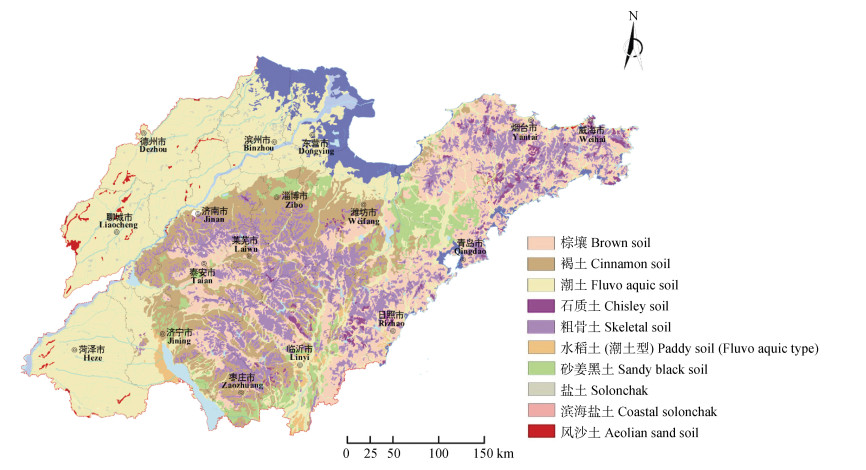
|
图 1 山东省土壤类型分布示意图 Fig. 1 Sketch map of soil type distribution in Shandong Province |
本次研究了棕壤、褐土、潮土、砂姜黑土、水稻土和粗骨土等6种主要耕地土壤类型(图 2)。棕壤主要分布于烟台(60.7×104 hm2)、青岛(48.26×104 hm2)、临沂(39.66×104 hm2)、威海(25.99×104 hm2)、泰安(25.33×104 hm2)和潍坊(23.62×104 hm2);褐土主要分布在潍坊(48.51×104 hm2)、临沂(33.17×104 hm2)、济南(27.88×104 hm2)和济宁(25.51×104 hm2);潮土主要分布在菏泽(114.41×104 hm2)、德州(99.4×104 hm2)、聊城(80.41×104 hm2)和滨州(63.39×104 hm2);砂姜黑土主要分布在青岛(23.44×104 hm2)、潍坊(15.14×104 hm2)和临沂(13.61×104 hm2);水稻土主要分布在济宁(5.95×104 hm2)和临沂(5.31×104 hm2);粗骨土主要分布在临沂(46.61×104 hm2)、烟台(41.6×104 hm2)和潍坊(22.52×104 hm2)。
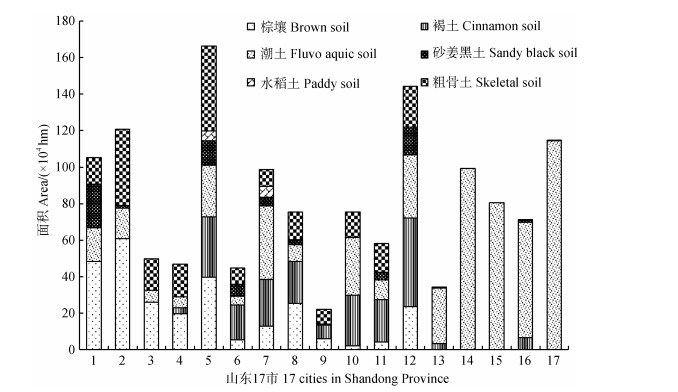
|
注:鲁东地区:1-青岛,2-烟台,3-威海;鲁南地区:4-日照,5-临沂;鲁中南地区:6-枣庄,7-济宁,8-泰安,9-莱芜;鲁中地区:10-济南,11-淄博,12-潍坊;鲁西和鲁北地区:13-东营,14-德州,15-聊城,16-滨州,17-菏泽。下同。 Note: East Shandong: 1-Qingdao, 2-Yantai, and 3-Weihai; South Shandong: 4-Rizhao and 5-Linyi; South Central Shandong: 6-Zaozhuang, 7-Jining, 8-Taian and 9-Laiwu; Central Shandong 10-Jinan, 11-Zibo, 12-Weifang; Northwest Shandong 13-Dongying, 14-Dezhou, 15-Liaocheng, 16-Binzhou and 17-Heze.. The same below. 图 2 山东省17市主要耕地土壤类型面积 Fig. 2 Areas of the main types of soils in the 17 cities in Shandong Province |
本研究的土壤pH数据来源于山东省土壤肥料总站承担的山东省第二次土壤普查省级汇总(1984年)和省级耕地地力评价(2015年)。第二次土壤普查省级汇总,采样时间1982-1984年,获得土壤pH数据3 827个,其中棕壤、褐土、潮土、砂姜黑土、水稻土和粗骨土样点3 222个,采样深度0~20 cm。省级耕地地力评价,采样时间为2013-2015年,土壤pH数据3.47万个,其中棕壤、褐土、潮土、砂姜黑土、水稻土和粗骨土样点3.37万个,采样深度0~20 cm。土壤样品采集与pH测定:采用多点混合法采集0~20 cm耕层土壤,经风干过2 mm筛后采用水土比1:1(第二次土壤普查省级汇总)、2.5:1(省级耕地地力评价),用电极法测定土壤pH。
1.3 数据处理 1.3.1 不同水土比测定pH比较由于第二次土壤普查省级汇总数据和省级耕地地力评价pH测定水土比不同,无法进行差值分析。在全省采集主要土壤类型土样60个,其中棕壤15个,褐土15个,潮土30个,按照水土比1:1和2.5:1,分别测定pH1和pH2.5。
试验数据表明,pH1范围从4.07~8.39,平均值为6.67,pH2.5范围从4.27~8.76,平均值为6.93。经回归分析得到总转换模型为pH2.5=1.019pH1+0.138 5(R2=0.997 2),国外也有学者建立和验证了类似的转换模型[24-25]。将通过模型计算的pH2.5与实测值进行t检验,发现二者不存在显著性差异(P > 0.05)。对统计模型计算的pH2.5与实测值,计算相对误差率,相对误差率均在1%以下,说明构建的模型具有可靠性。
1.3.2 耕地土壤pH分布图制作山东省第二次土壤普查土壤pH分布图,是以第二次土壤普查土壤pH点位数值为基础,以土种图为评价单元,按相同等级勾绘连片形成pH图斑,经逐级缩编而成;耕地pH等级面积是将第二次土壤普查土壤pH分布图进行数字化与土地利用现状图进行叠加获得。山东省耕地地力评价土壤pH分布图,是基于2015年省级耕地地力评价的土壤pH点位数据,采用反距离插值法获得;耕地pH等级面积是利用耕地地力评价土壤pH分布图与土地利用现状图进行叠加获得。
1.3.3 分级标准参考《山东耕地》[26]pH等级划分标准,根据山东土壤酸碱状况,将全省土壤划分为强酸性、中强酸性、酸性、弱酸性、中性、弱碱性和碱性7个等级(表 1)。
|
|
表 1 山东省耕层土壤pH分级标准 Table 1 Grading of the topsoils of cultivated lands in Shandong Province by soil pH |
采用Excel 2013和SPSS 19.0软件进行统计分析,采用独立样本t检验对土壤pH进行差异性检验。
2 结果 2.1 山东省土壤pH的总体变化趋势通过两个时期比较,近30年来,全省耕地土壤pH呈降低趋势,并出现局部耕地酸化,pH平均值由7.6降至7.2,降低0.4个单位。第二次土壤普查省级汇总数据显示,全省弱酸性(5.5 < pH≤6.5)、中性(6.5 < pH≤7.5)、弱碱性(7.5 < pH≤8.5)和碱性(pH > 8.5)耕地面积分别占当时耕地总面积的11.07%、30.36%、58.45%和0.12%。省级耕地地力评价数据显示,全省中强酸性、酸性、弱酸性、中性、弱碱性和碱性耕地分别占耕地总面积的0.98%、6.06%、20.43%、26.66%、45.65%和0.22%(图 3)。
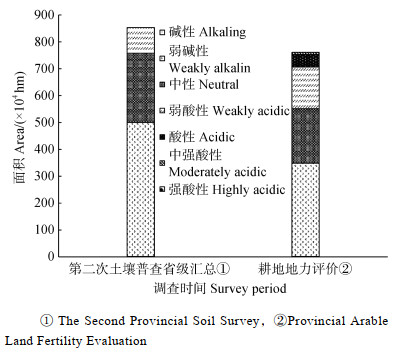
|
图 3 山东省耕地土壤pH等级面积 Fig. 3 Area of cultivated land in Shandong Province relative to soil pH grade |
从全省土壤酸碱性分级看,弱碱性和中性耕地面积占比均出现下降,分别减少了12.8和3.7个百分点;弱酸性耕地面积占比由11.07%增加至20.43%,增加了9.36个百分点;出现了酸性和中强酸性耕地,占比7.04个百分点;碱性耕地面积占比略有增加,由0.12%增加至0.22%,增加了0.1个百分点。
2.2 山东省不同地区土壤pH的变化趋势调查数据(表 2)显示,山东省不同地市酸碱度变化差异较大,威海变化最大,降低了1.3个单位;其次是泰安、日照、烟台、青岛和临沂,分别降低了1.1、1.1、1.0、1.0和0.8个单位。济南升高了0.1个单位。其他无显著变化。威海、烟台、日照、青岛、临沂和枣庄6市土壤出现了酸化(图 4),其中,中强酸性土壤占比分别为14.82%、3.67%、4.72%、1.22%、1.4%和0.08%,酸化面积分别为13.32×104 hm2、19.51×104 hm2、6.14×104 hm2、8.227×104 hm2、6.207×104 hm2和0.173×104 hm2。
|
|
表 2 山东省17市土壤pH平均值 Table 2 Average soil pH of cultivated land relative to city in Shandong Province |
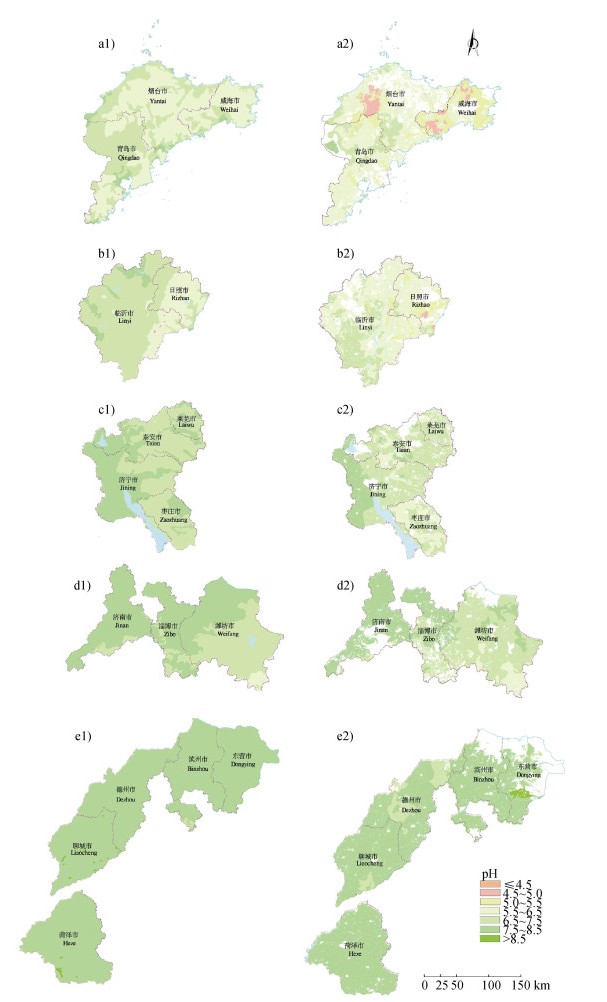
|
注:a1)、a2)鲁东地区,b1)、b2)鲁南地区,c1)、c2)鲁中南地区,d1)、d2)鲁中地区,e1)、e2)鲁西和鲁北地区;1)为1984年,2)为2015年。白色区域为非耕地。 Note: a1), a2) East Shandong; b1), and b2) South Shandong; c1) and c2) South central Shandong; d1) and d2) Central Shandong; e1) and e2) Northwest Shandong province. 1) for 1984, 2) for 2015. White area: Non cultivated land. 图 4 山东省土壤pH及变化空间分布 Fig. 4 Spatial distribution of soil pH in Shandong Province |
以上数据分析得出,从空间上看,山东省土壤酸碱度区域差异极大,并呈现从西向东降低趋势。其中鲁东地区两时期平均pH最低,分别为6.8和5.9;鲁西和鲁北地区平均pH最高,分别为8.1和8.0。从时间上看,每个区域土壤pH等级在两个时期均出现了从碱性到酸性变化趋势,但pH降幅出现从东向西变小的趋势。从土壤酸碱性分级上看,鲁西和鲁北地区、鲁中地区土壤主要由集中弱碱性变化为弱碱性、中性。鲁中南地区土壤主要由弱碱性、中性变化为弱碱性、中性、弱酸性。鲁东地区、鲁南地区土壤由弱碱性、中性、弱酸性变化为弱碱性、中性、弱酸性、酸性、中强酸性(图 4)。
2.3 山东省不同土壤类型pH的变化趋势调查数据(表 3)可以看出,山东省不同土壤类型(耕地)酸碱度差异较大,从山东省的东南棕壤区到西北潮土区,土壤pH由低到高。
|
|
表 3 山东省不同土壤类型土壤pH平均值 Table 3 Average soil pH relative to soil type in Shandong Province |
第二次土壤普查省级汇总,全省主要土壤类型土壤pH由大到小依次为:潮土、水稻土、褐土、砂姜黑土、粗骨土和棕壤。潮土pH最高,为8.0;棕壤pH最低,为6.8,其高值与低值相差1.2个单位。省级耕地地力评价,全省主要类型土壤pH由大到小依次为:潮土、褐土、砂姜黑土、水稻土、粗骨土和棕壤。潮土pH最高,为7.8;棕壤pH最低,为6.0,其高值与低值相差1.8个单位。
二者对比看出,无论何种土壤类型土壤pH均呈下降趋势,由大到小依次为:水稻土、棕壤、粗骨土、砂姜黑土、褐土和潮土。其中水稻土、棕壤土类下降最为明显,分别下降1.0和0.8个单位。
3 讨论 3.1 土壤类型对土壤pH的影响研究表明,土壤本身抵制酸碱变化的能力与土壤的物质组成和地球化学性质相关,不同土壤类型的酸碱缓冲性能有所不同[27],安徽省潮土、砂姜黑土、水稻土依次降低[28],浙江省盐土、潮土、水稻土依次降低[29],长春市黑钙土、草甸土、黑土、白浆土和暗棕壤逐渐下降[30],棕壤、水稻土酸碱缓冲性能较弱。本研究中(表 3和图 2),第二次土壤普查省级汇总时,棕壤和粗骨土的pH平均值分别为6.8、6.0,省级耕地地力评价时,棕壤和粗骨土的pH平均值分别为7.0、6.4,均为6种土壤类型中最低;变化量分别为0.8和0.6个单位,相对较高。水稻土则变化量最大,为1个单位。发生酸化的威海、烟台、日照、临沂和枣庄等市土壤多为棕壤和粗骨土土类(图 1),成土母质以酸性为主。据统计,威海、烟台和日照等市棕壤和粗骨土占比超过了70%,青岛和临沂市达到了50%,酸化土壤占比最少的枣庄市也有20%左右。因为棕壤主要由酸性岩、基性岩等含盐基很少的岩石风化物发育而成,形成过程产生的钙、镁、钾、钠等盐基离子不断受到渗透水的淋洗,土壤胶体表面一部分正离子吸附点被氢、铝离子占据,产生了交换性酸;粗骨土的成土母质与棕壤相同,成土过程阳离子交换量小,酸碱缓冲性能较弱[27]。
3.2 不同作物收获对土壤pH的影响研究表明,植物收获对土壤pH有所影响,不同植物对土壤中阳离子(K+、NH4+、Ca2+、Mg2+等)和阴离子(NO3-、SO42-、PO43-等)养分元素的吸收并不平衡,当阳离子的吸收大于阴离子时,植物根系从土壤吸收阳离子的同时就分泌出H+以保持体系的电荷平衡[31],当农产品收获并从土地上移走,其体内积累的碱性物质也随之带走,会导致土壤酸化[32]。朱齐超[33]量化研究了土壤酸化的影响因素,计算得到作物收获在土壤酸化的驱动因素中可达到34.2%。参考2012年《山东统计年鉴》[34]中山东省主要农产品产量,根据作物收获带走盐基离子浓度和含水量[35],估算了2011年山东省主要作物收获从土壤中带走的盐基养分量(表 4),马铃薯盐基离子带走量最大,为140.9 kmol·hm-2,其次是玉米和小麦,分别为97.2和79.7 kmol·hm-2。对胶东地区不同种植体系的研究则表明,蔬菜、苹果、小麦/玉米/花生体系农田酸化速度明显高于小麦/玉米体系[36]。
|
|
表 4 不同作物收获带走盐基离子量 Table 4 Amount of base ions removed with crop harvest relative to crop/(kmol·hm-2) |
研究表明,长期的不合理施肥,特别是施用硫酸铵、氯化钾、氯化铵等酸性肥料,是土壤酸化的原因之一[37],土壤酸化的驱动因素中施肥贡献了55.1%[33]。本研究中,山东省酸性土壤分布较多的烟台、日照、枣庄和青岛市化肥施用强度均较高(图 5)[38],分别为650.6 kg·hm-2、542.7 kg·hm-2、488.4 kg·hm-2和433.2·kg hm-2;烟台、日照、枣庄和威海市氮肥施用强度较高,分别为242.4 kg·hm-2、195.6 kg·hm-2、186.0 kg·hm-2和174.8 kg·hm-2。有研究表明,山东胶东地区氮肥用量与土壤pH呈负相关关系,氮肥施用量越大,土壤pH越低。氮肥施用量小于240 kg·hm-2,土壤pH降为5.35;氮肥施用量为240~750 kg·hm-2之间,土壤pH降为5.28;氮肥施用量大于750 kg·hm-2,土壤pH降为5.16[36]。因为长期连年施用化学肥料,作物吸收后剩下的酸根会与土壤中氢离子结合生成酸,导致土壤酸性增强。生理酸性肥料如氮肥中硫酸铵、氯化铵施入土壤后,被植物选择吸收
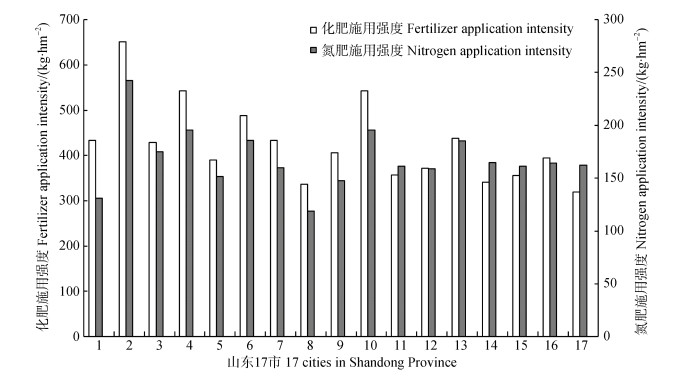
|
图 5 2000-2011年山东省各市化肥施用强度(统计自2000-2011年《山东统计年鉴》) Fig. 5 Intensity of fertilizer application, relative to city in Shandong Province in 2000-2011(Statistics from 2000 to 2011 Shandong statistical yearbook) |
土壤pH变化是一个相对较慢的过程,但由于现代化工业和农业措施的影响,各地土壤pH有了一定变化。通过比较第二次土壤普查省级汇总(1984年)和省级耕地地力评价(2015年)两个时期山东省土壤pH数据,30年来,山东省土壤pH平均值由7.6降至7.2。威海变化最大,降低了1.3个单位,其次是泰安、日照、烟台和青岛,分别降低了1.1、1.1、1.0和1.0个单位。不同类型土壤pH变化由大到小依次为:水稻土、棕壤、粗骨土、砂姜黑土、褐土和潮土。目前,山东省酸性土壤主要分布在胶东半岛和东南部沿海的威海、烟台、青岛、日照、临沂和枣庄等6个市,其中烟台和威海市酸化面积较大。对山东省耕地土壤酸化主要影响因素分析发现,土壤类型、植物收获以及化肥不适当施用有一定影响,但不同地区土壤酸碱性变化的影响因素、不同土壤类型的酸碱缓冲性能差异等仍需要进一步定量研究分析,以明确具体原因。
| [1] |
Zhao B Q, Li X Y, Li X P, et al. Long-term fertilizer experiment network in China:Crop yields and soil nutrient trends[J]. Agronomy Journal, 2010, 102(1): 216-230. DOI:10.2134/agronj2009.0182
(  0) 0) |
| [2] |
Curtin D, Trolove S. Predicting pH buffering capacity of New Zealand soils from organic matter content and mineral characteristics[J]. Soil Research, 2013, 51(6): 494-502. DOI:10.1071/SR13137
(  0) 0) |
| [3] |
Guo J H, Liu X J, Zhang Y, et al. Significant acidification in major Chinese croplands[J]. Science, 2010, 327(5968): 1008-1010. DOI:10.1126/science.1182570
(  0) 0) |
| [4] |
Xu R K. Research progresses in soil acidification and its control (In Chinese)[J]. Soils, 2015, 47(2): 238-244. [徐仁扣. 土壤酸化及其调控研究进展[J]. 土壤, 2015, 47(2): 238-244.]
(  0) 0) |
| [5] |
Goulding K W T, Blake L. Land use, liming and the mobilization of potentially toxic metals[J]. Agriculture, Ecosystems & Environment, 1998, 67(2/3): 135-144.
(  0) 0) |
| [6] |
Minasny B, Hong S Y, Hartemink A E, et al. Soil pH increase under paddy in South Korea between 2000 and 2012[J]. Agriculture, Ecosystems & Environment, 2016, 221: 205-213.
(  0) 0) |
| [7] |
Yang Y H, Ji C J, Ma W H, et al. Significant soil acidification across Northern China's grasslands during 1980s-2000s[J]. Global Change Biology, 2012, 18(7): 2292-2300. DOI:10.1111/j.1365-2486.2012.02694.x
(  0) 0) |
| [8] |
Zeng Z B, Zeng S J, Liu Y F, et al. Change tendency of paddy soil pH in Guangdong Province since 1984 and influential factors (In Chinese)[J]. Soils, 2014, 46(4): 732-736. [曾招兵, 曾思坚, 刘一锋, 等. 1984年以来广东水稻土pH变化趋势及影响因素[J]. 土壤, 2014, 46(4): 732-736.]
(  0) 0) |
| [9] |
Guo X, Li H Y, Yu H M, et al. Drivers of spatio-temporal changes in paddy soil pH in Jiangxi Province, China from 1980 to 2010[J]. Scientific Reports, 2018, 8: 2702. DOI:10.1038/s41598-018-20873-5
(  0) 0) |
| [10] |
Cheng X F, Chen M C, Hao L X, et al. Spatio-temporal variation of soil acidification in hilly red soil croplands (In Chinese)[J]. Chinese Journal of Eco-Agriculture, 2008, 16(6): 1348-1351. [程先富, 陈梦春, 郝李霞, 等. 红壤丘陵区农田土壤酸化的时空变化研究[J]. 中国生态农业学报, 2008, 16(6): 1348-1351.]
(  0) 0) |
| [11] |
Hu M, Xiang Y S, Zhang Z, et al. Variation characteristics of farmland soil pH in the past 30 years of Enshi Autonomous Prefecture, Hubei, China (In Chinese)[J]. Chinese Journal of Applied Ecology, 2017, 28(4): 1289-1297. [胡敏, 向永生, 张智, 等. 恩施州耕地土壤pH近30年变化特征[J]. 应用生态学报, 2017, 28(4): 1289-1297.]
(  0) 0) |
| [12] |
Sun X M, Yan J Y, Cheng D Q, et al. Arable land soil pH situation and acidic soil regulation approaches in Henan (In Chinese)[J]. Chinese Agricultural Science Bulletin, 2017, 33(24): 91-94. [孙笑梅, 闫军营, 程道全, 等. 河南省耕地土壤酸碱度状况与酸化土壤治理途径[J]. 中国农学通报, 2017, 33(24): 91-94.]
(  0) 0) |
| [13] |
Wang Y, Zhang X Y, Gao Q, et al. Temporal and spatial variability of soil pH in cropland of Jilin Province (In Chinese)[J]. Chinese Journal of Soil Science, 2017, 48(2): 387-391. [王寅, 张馨月, 高强, 等. 吉林省农田耕层土壤pH的时空变化特征[J]. 土壤通报, 2017, 48(2): 387-391.]
(  0) 0) |
| [14] |
Bai S B, Pei J B, Li S Y, et al. Temporal and spatial dynamics of soil organic matter and pH in cultivated land of Liaoning Province during the past 30 years (In Chinese)[J]. Chinese Journal of Soil Science, 2016, 47(3): 636-644. [白树彬, 裴久渤, 李双异, 等. 30年来辽宁省耕地土壤有机质与pH时空动态变化[J]. 土壤通报, 2016, 47(3): 636-644.]
(  0) 0) |
| [15] |
Bowman W D, Cleveland C C, Halada Ĺ, et al. Negative impact of nitrogen deposition on soil buffering capacity[J]. Nature Geoscience, 2008, 1(11): 767-770. DOI:10.1038/ngeo339
(  0) 0) |
| [16] |
Meng H Q, Liu J, Xu M G, et al. Evolution of pH in topsoils of typical Chinese croplands under long-term fertilization (In Chinese)[J]. Acta Pedologica Sinica, 2013, 50(6): 1109-1116. [孟红旗, 刘景, 徐明岗, 等. 长期施肥下我国典型农田耕层土壤的pH演变[J]. 土壤学报, 2013, 50(6): 1109-1116.]
(  0) 0) |
| [17] |
孟红旗.长期施肥农田的土壤酸化特征与机制研究[D].陕西杨凌: 西北农林科技大学, 2013. Meng H Q. Characteristics and mechanisms for soil acidification under long-term fertilization in Chinese croplands[D]. Yangling, Shaanxi: Northwest A & F University, 2013. (  0) 0) |
| [18] |
Zhang Z Q, Mao P, Yu D S, et al. Characteristics of soil pH variation in typical red soil region of South China in the past 25 years-A case study of Yujiang County, Jiangxi Province (In Chinese)[J]. Acta Pedologica Sinica, 2018, 55(6): 1545-1553. [张忠启, 茆彭, 于东升, 等. 近25年来典型红壤区土壤pH变化特征——以江西省余江县为例[J]. 土壤学报, 2018, 55(6): 1545-1553.]
(  0) 0) |
| [19] |
Wang C L, Zeng X D, Liu H F, et al. The present situation of soil environmental quality and the distribution and migration regularity of heavy metals in soil of Yantai (In Chinese)[J]. Geology in China, 2015, 42(1): 317-330. [王存龙, 曾宪东, 刘华峰, 等. 烟台市土壤环境质量现状及重金属元素分布迁移规律[J]. 中国地质, 2015, 42(1): 317-330.]
(  0) 0) |
| [20] |
Zhao Q G, Lu S C, Wu D M, et al. Effect on the farmland soil acidification and nutrients change in Zhaoyuan City by fertilizer application (In Chinese)[J]. Chinese Agricultural Science Bulletin, 2008, 24(1): 301-306. [赵全桂, 卢树昌, 吴德敏, 等. 施肥投入对招远农田土壤酸化及养分变化的影响[J]. 中国农学通报, 2008, 24(1): 301-306.]
(  0) 0) |
| [21] |
Ge S F, Hao W Q, Jiang H, et al. Distribution characteristics of soil organic matter and pH and the correlation to soil nutrients in apple orchards of Yantai (In Chinese)[J]. Chinese Agricultural Science Bulletin, 2014, 30(13): 274-278. [葛顺峰, 郝文强, 姜翰, 等. 烟台苹果产区土壤有机质和pH分布特征及其与土壤养分的关系[J]. 中国农学通报, 2014, 30(13): 274-278.]
(  0) 0) |
| [22] |
山东省人民政府.地理资源[OL]. http://www.shandong.gov.cn/art/2014/5/14/art_2961_71095.html.2019-08-14. Shandong Provincial People's Government. Geographical resources[OL]. http://www.shandong.gov.cn/art/2014/5/14/art_2961_71095.html.2019-08-14. (  0) 0) |
| [23] |
Soil and Fertilizer Station of Shandong Province. Shandong soils (In Chinese). Beijing: China Agriculture Press, 1994. [山东省土壤肥料工作站. 山东土壤[M]. 北京: 中国农业出版社, 1994.]
(  0) 0) |
| [24] |
Kabała C, Musztyfaga E, Gałka B, et al. Conversion of soil pH 1:2.5 KCl and 1:2.5 H2O to 1:5 H2O:Conclusions for soil management, environmental monitoring, and international soil databases[J]. Polish Journal of Environmental Studies, 2016, 25(2): 647-653. DOI:10.15244/pjoes/61549
(  0) 0) |
| [25] |
Libohova Z, Wills S, Odgers N P, et al. Converting pH1:1 H2O and 1:2CaCl2 to 1:5 H2O to contribute to a harmonized global soil database[J]. Geoderma, 2014, 213: 544-550. DOI:10.1016/j.geoderma.2013.08.019
(  0) 0) |
| [26] |
Soil and Fertilizer Station of Shandong Province. Shandong cultivated land (In Chinese). Beijing: China Agriculture Press, 2018. [山东省土壤肥料总站. 山东耕地[M]. 北京: 中国农业出版社, 2018.]
(  0) 0) |
| [27] |
Wang Z G, Zhao Y C, Liao Q L, et al. Spatio-temporal variation and associated affecting factors of soil pH in the past 20 years of Jiangsu Province, China (In Chinese)[J]. Acta Ecologica Sinica, 2008, 28(2): 720-727. [王志刚, 赵永存, 廖启林, 等. 近20年来江苏省土壤pH值时空变化及其驱动力[J]. 生态学报, 2008, 28(2): 720-727.]
(  0) 0) |
| [28] |
Wang W J, Dai W H. Study on soil pH and acidic buffering properties in Anhui Province (In Chinese)[J]. Chinese Agricultural Science Bulletin, 2012, 28(15): 67-72. [王文婧, 戴万宏. 安徽主要土壤酸碱性及其酸缓冲性能研究[J]. 中国农学通报, 2012, 28(15): 67-72.]
(  0) 0) |
| [29] |
Li J G, Zhang M K, Zhou C. A study on acidic buffer capacity of agricultural soils in Zhejiang Province (In Chinese)[J]. Acta Agriculturae Zhejiangensis, 2005, 17(4): 207-211. [李建国, 章明奎, 周翠. 浙江省农业土壤酸缓冲性能的研究[J]. 浙江农业学报, 2005, 17(4): 207-211.]
(  0) 0) |
| [30] |
Liu W, Shang Q C. Buffer action and its influencing factors of different types of soil in Changchun region (In Chinese)[J]. Journal of Jilin Agricultural University, 2001, 23(3): 78-82. [刘伟, 尚庆昌. 长春地区不同类型土壤的缓冲性及其影响因素[J]. 吉林农业大学学报, 2001, 23(3): 78-82.]
(  0) 0) |
| [31] |
范庆锋.保护地土壤酸度特征及酸化机理研究[D].沈阳: 沈阳农业大学, 2009. Fan Q F. Acidity characteristics and acidification mechanism of soils in protected fields[D]. Shenyang: Shenyang Agricultural University, 2009. http://cdmd.cnki.com.cn/Article/CDMD-10157-2009156968.htm (  0) 0) |
| [32] |
Song W F, Wang C, Chen R F, et al. Comparison of contribution of wheat ionic uptake to soil acidification under long-term different fertilization (In Chinese)[J]. Soils, 2017, 49(1): 7-12. [宋文峰, 王超, 陈荣府, 等. 长期不同施肥下小麦离子吸收对土壤酸化贡献能力的比较[J]. 土壤, 2017, 49(1): 7-12.]
(  0) 0) |
| [33] |
朱齐超.区域尺度中国土壤酸化定量研究及模型分析[D].北京: 中国农业大学, 2017. Zhu Q C. Quantification and modelling of soil acidification at regional scale of China[D]. Beijing: China Agricultural University, 2017. (  0) 0) |
| [34] |
Shandong Bureau of Statistics. Shandong statistical yearbook (In Chinese). Beijing: China Statistics Press, 2012. [山东统计局. 山东统计年鉴[M]. 北京: 中国统计出版社, 2012.]
(  0) 0) |
| [35] |
Zhu Q C, de Vries W, Liu X J, et al. Enhanced acidification in Chinese croplands as derived from element budgets in the period 1980-2010[J]. Science of the Total Environment, 2018, 618: 1497-1505. DOI:10.1016/j.scitotenv.2017.09.289
(  0) 0) |
| [36] |
周海燕.胶东集约化农田土壤酸化效应及改良调控途径[D].北京: 中国农业大学, 2015. Zhou H Y. Effects of cropland soil acidification and remediation in Jiaodong of Shandong Province[D]. Beijing: China Agricultural University, 2015. (  0) 0) |
| [37] |
Hao T X, Zhu Q C, Zeng M F, et al. Quantification of the contribution of nitrogen fertilization and crop harvesting to soil acidification in a wheat-maize double cropping system[J]. Plant and Soil, 2019, 434(1/2): 167-184.
(  0) 0) |
| [38] |
Shandong Bureau of Statistics. Shandong statistical yearbook(2000-2011) (In Chinese). Beijing: China Statistics Press. [山东统计局. 山东统计年鉴(2000-2011年)[M]. 北京: 中国统计出版社.]
(  0) 0) |
 2021, Vol. 58
2021, Vol. 58


